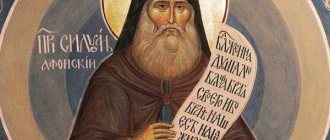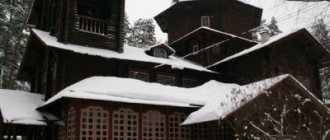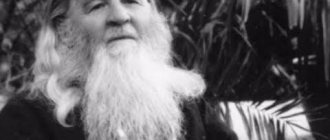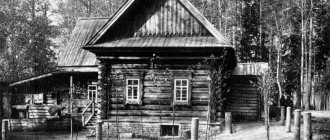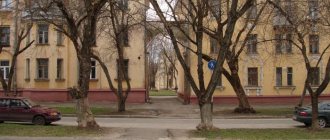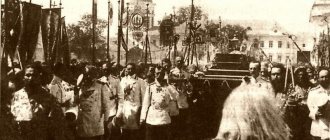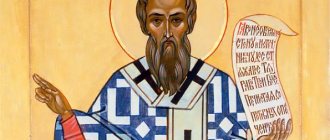Bishop Seraphim (Glushakov) reposed in the Lord.
On June 9, 2022, at the 52nd year of his life, Bishop Seraphim (Glushakov) reposed in the Lord.
Bishop Seraphim (Fedor Mikhailovich Glushakov) was born on March 19, 1969 in the city of Karaganda into an Orthodox family expelled to Kazakhstan during the repressions of the 1930s. In 1986 he graduated from school and entered the Moscow Theological Seminary. Then he entered the Holy Dormition Pskov-Pechersky Monastery as a novice. On February 16, 1992, Archbishop Proclus of Ulyanovsk and Melekess ordained him a deacon. On July 5, 1992, Archbishop Eusebius of Samara and Syzran ordained him a priest and appointed rector of the Holy Resurrection Cathedral under construction in the city of Samara. Graduated from Kuibyshev State Pedagogical University. On June 23, 1998, with the blessing of the Archbishop of Samara and Syzran, Sergius (now Metropolitan of Samara and Novokuybyshevsk) took monastic vows with the name Seraphim. In 2000 he was elevated to the rank of abbot. He graduated from the Moscow Theological Academy with a candidate's degree in theology. In 2003, by decision of the Holy Synod, the Samara Resurrection Cathedral was transformed into the Holy Resurrection Monastery, Father Seraphim was appointed abbot of the monastery. Graduated with honors from the Faculty of Law of the Volga Region Academy of Public Administration named after P.A. Stolypin. He taught at the Samara Theological Seminary and Samara State Economic University. In 2010 he was elevated to the rank of archimandrite.
By the decision of the Holy Synod of March 22, 2011, he was elected Bishop of Resurrection, vicar of the Moscow diocese. On May 21 of the same year, on the day of the Council of New Martyrs, victims in Butovo, His Holiness Patriarch Kirill led the rite of naming Archimandrite Seraphim (Glushakov) Bishop of the Resurrection in the Church of the New Martyrs and Confessors of Russia at the Butovo training ground. On May 22, 2011, on the feast of the transfer of the relics of St. Nicholas the Wonderworker, at the Divine Liturgy in the Transfiguration Cathedral of the St. Nicholas Ugresh Monastery, His Holiness Patriarch Kirill led the consecration of Archimandrite Seraphim as Bishop of the Resurrection, vicar of the Moscow diocese. By the decision of the Holy Synod of May 30, 2011, he was appointed His Eminence of Anadyr and Chukotka. By the decision of the Holy Synod of December 24, 2015, he was retired and placed at the disposal of Metropolitan Sergius of Samara and Syzran. The Synod determined the city of Samara to be its seat.
At the end of May, Bishop Seraphim was hospitalized with a stroke in the intensive care unit of the Railway Hospital in Samara, where he spent more than two weeks. There he was given unction, confessed and given communion by the current abbot of the Holy Resurrection Monastery, Hieromonk Seraphim (Astapenko). Bishop Seraphim could then speak and answer questions in confession. After communion he felt better. Bishop Seraphim was even transferred from intensive care to a regular ward. But then we had to return him to the intensive care unit again...
On June 11, 2022, the funeral service for the newly deceased Bishop Seraphim (Glushakov) took place at the Holy Resurrection Monastery. The Divine Liturgy and funeral service were led by Metropolitan Sergius of Samara and Novokuibyshevsk. Concelebrating with him were Bishop Sophrony of Kinel and Bezenchuk and Bishop Nikifor of Otradnensky and Pokhvistnevsky. The clergy of the Samara Metropolis and the laity came to say goodbye to the newly departed Bishop.
My little brother
We asked the sister of the late Bishop Seraphim, Elena Mikhailovna Soluyanova , to share her memories of her brother.
— We were nine brothers and sisters, Vladyka Seraphim was the youngest of the brothers. I am the oldest of the sisters, and the age difference with my brother Fedor is six and a half years. We grew up in a pious family, under the spiritual guidance of the famous Optina ascetic, St. Sebastian of Karaganda; our dad, Mikhail Glushakov, was his driver. Reverend Sebastian (Fomin) died in 1966, and although I was little then, I remembered him well and kept his image in my heart. Now his relics have already been found, he has been glorified as a saint, and for us, St. Sebastian is like a part of our life, our family. Father Sebastian married our father and mother. Dad was widowed early and was left with four small children, among whom was the future Vladyka Seraphim, then Fyodor. Later, my father took monastic vows with the name Sebastian, in memory of his spiritual mentor. The pope is buried at the Samara Chernovskoye cemetery, where the skete of the Iversky Monastery is. Now his son, Bishop Seraphim (Glushakov), rests next to him. Our mother Anna was an amazing woman! How many people did she lead to faith... Dad worked, and she was a housewife, an adviser to her husband. She sewed church vestments for the Monk Sebastian of Karganda, for other priests of the St. Michael's Church in the St. Michael's village of Karaganda (now there is a monastery there). She sang in the temple.
When Fyodor Glushakov was little, a significant incident happened to him. He, three years old, was given his staff to hold by the famous ascetic Metropolitan Joseph of Alma-Ata and Kazakhstan, whose relics are now being prepared to be recovered. Metropolitan Joseph said mysterious words to Fedya: “You will be a ruler!” The prediction came true.
As children, we communicated a lot with icon painter nuns close to Father Sebastian—Mother Agnia and Mother Anastasia. They, too, somehow singled out Fedya from all of us in a special way, giving him decorated Easter eggs, usually ones with a picture of a temple on them. This is probably not a coincidence either.
Lord Seraphim had seven sisters and only one brother - Vladimir. Vladimir and I are twins, he is forty minutes older than me. It was hard for us to be without each other for a long time. That’s why, when the time came for him to join the army in 1980, he definitely wanted to say goodbye to me. I was then studying at the regency department at the Moscow Theological Academy. My brother flew to me there by plane. In the church, at the relics of St. Sergius, an akathist to this saint was read. I stayed for the akathist, and Vladimir and a fellow seminarian went for a bike ride around the Lavra. I didn’t want to let him go!.. I listen to the words of the akathist, but my soul is uneasy. Such alarm suddenly arose! I look - on the old Rublevsky image of the Savior not made by hands, tears are flowing from the eyes... Such a miracle... Soon everything was explained.
When they left the Lavra walls, my brother was hit by a car. A general who lived next to the Lavra had a daughter that day, so he got into the car to celebrate and “tipsy” - and ran over Vladimir... The car ran over him from behind... His brother died in the hospital... He was buried in the Lavra cemetery. This tragedy shortened our mother’s days; two years later she died. And I have only one brother left - Fedor. When I married a seminarian, a future priest, we went to my husband’s homeland in Samara-Kuibyshev. It was then that I invited Fyodor Glushakov to come here to us. This is how Vladyka Seraphim ended up here in Samara in 1992.
|
He was offered to take on the construction of the Holy Resurrection Church. This was a terribly neglected corner of Bezymyanka. Two experienced priests refused such construction, they did not dare to take on such a big job. There was not a single temple on Bezymyanka before. In that square overgrown with weeds, crime flourished; it was rumored that those killed in gang clashes were secretly buried there at night (the “dashing 90s”). It was dirty and untidy. And look what Lord Seraphim left behind! How much prayer and work was needed to transform this corner of Samara! A beautiful temple, a decoration of the whole city. High monastery walls, chapels on the towers, wonderful monastery buildings. Why isn’t there now! And how many beautiful trees, apple trees, especially spruces my brother planted there with his own hands! Several rows of his trees... He loved this place, ennobled it. I put my whole soul into this monastery. He told me more than once that he was not afraid to die, leaving behind such a spiritual pearl!..
When hard times came for him, when he returned to Samara from Chukotka, he was very sad. Sometimes he would come to me and remain silent. He says, turn off the light, sister, let’s sit in silence, just be silent, and so they sat. I don’t know what he was thinking about. But it was difficult for him. I supported him as best I could. And then he did not forget his monastery. It used to be that we would drive up to the monastery walls by car, stop the car, and sit next to them. He looked at the monastery, just looked... He’ll sit, look, gain strength - and then we’ll move on.
I know, and I myself have heard more than once how someone condemns my brother. Some simply did not understand him, while others slandered him, in different ways. And so I’ll tell them this: we all have some weaknesses and sins, but we don’t know everything about the good deeds of our neighbors. And my brother had a lot of such cases. And the main thing is, of course, the Resurrection Monastery. He put his soul into it. I think that he had, as it were, two offspring: his niece Lyudmila, she is already a mother, her priest husband serves near Rostov, she was like a daughter to Vladyka Seraphim, and he was her godfather. And so the Holy Resurrection Monastery became the second such brainchild for my brother. And to those who are so quick to condemn, I will also say: for those who came to serve with everything ready-made, it is difficult for them to understand what my brother had to go through when he created a huge monastery literally stone by stone, when he erected temples and walls of the monastery. With everything ready-made, is it really as difficult as it was for him? So don’t rush to judgment. Not every one of us will leave behind such a treasure, such a monastery as Bishop Seraphim left for our city. Eternal memory to him!
Rest, O Lord, the soul of Your servant, the newly departed Bishop Seraphim, and forgive him all his sins, voluntary and involuntary, and grant him the Kingdom of Heaven!
Prayers
The troparion, kontakion and prayer to St. Seraphim were approved at a meeting of the Holy Synod on February 3, 2016 [16].
Troparion, tone 4
We are constantly inflamed with divine zeal, / You appeared as a pillar of Orthodoxy, / You rose up in the city of Sophia, / and through your piety you brought many people to Christ, / to the good shepherd, the saint Seraphim,/ pray to Christ God,// to save our souls.
Troparion, tone 5
The vessel of the Divine gifts/ and the house of the Holy Trinity appeared,/ to the miracle-working saint Father Seraphim,/ also, having boldness towards the Lord,/ do not leave us orphans/ and, as you promised here,/ obtain for us through your prayers// peace and great mercy.
Kontakion, tone 4
(Similar to: Ascended to the Cross:)
Ascend to the heights of humility, / You have appeared as a teacher of piety, / Champion of Orthodoxy and the representative of the strange, / Praise to the monastics and a fair shepherd. / Moreover, we call you to love: / Ra Pout, Seraphim, miracle worker.
[17]
Blessed Mary prayed for him
I also want to pay tribute to Bishop Seraphim. I’ll tell you about one significant episode from his life. We have known each other for a very long time, but most of all we communicated precisely at the time when the famous blessed Maria Ivanovna Matukasova, who later became a schema-nun, lived at the Resurrection parish that was just beginning to take shape. At first she lived in the abbot’s chambers. Just imagine, she literally slept on the threshold of his cell. On the floor! She laid her head, as if on a pillow, on his high abbot’s threshold. And everyone who entered or left there was sure to step over it. Moreover, her cell attendant Tamara Stepanovna was also sleeping on the threshold next to her. They read akathists, the Psalter of the Mother of God... It was such powerful foolishness in Christ that everyone who saw it was amazed. Father Theodore (then he was still Father Feodor Glushakov) was also quite embarrassed by this. He told me that many times he suggested that the old lady move to where it would be more comfortable, on the leather sofa in his already very representative office. But the blessed one did not agree to move. She said: “I’ll lie here, it’s more necessary here, it’s coming, it’s coming.” I think she protected him like that with prayer. And she begged for the place where the monastery was destined to rise. She predicted a glorious future for this monastery itself. She said that in difficult years this monastery (of which there was no trace yet!) would feed the entire neighborhood... I don’t know what she meant, spiritual or material food. And also, with her fiery prayer, she seemed to keep demons out of the abbot’s chambers. It’s a pity I didn’t live with him there for very long. Then the abbot gave her a small house on the territory of the Church of the Resurrection and persuaded her to move there. This was in the fall of 1995. And she lived in this house near the temple for about a year before she left for Optina Pustyn. There, in this house of hers, we made a film about the blessed old woman Maria Ivanovna, about this film she only said then: “A lot of light!..”. The film also captured well the construction realities of that time for the future large monastery.
And at a time when Mother Maria was still living on the threshold of his chambers, one day the old lady blessed me to spend the night here with him. It’s clear that I didn’t agree to spend the night on the threshold, what do I care about the blessed old lady. And Father Seraphim fulfilled her wish. He left me to spend the night at the parish, but, of course, in quite comfortable conditions. He even rode horses around the city with me at night (he offered me a “governor’s” stallion as a sign of cordiality; he was a big man!). He even had a stable at the temple back then.
A bright, talented, active man went to the Lord. The Resurrection Monastery preserves the memory of its builder and first governor. The monastery became one of the spiritual strongholds on Samara soil. This is precisely the great deed that he managed to accomplish brilliantly. It is no coincidence that blessed schema-nun Maria prayed so much for him, as for the future monastery!
Anton Zhogolev.
Literature
- Church Led.
, 1912, № 50, 421. - —
, 1913, № 2, 10. - ZhMP
, 1945, № 5, 22. - —
, 1946, № 4, 19. - —
, 1950, № 4, 20-28. - FPS I
, №106, 4. - FPS III
, 6. - FAM I
, № 232, 18. - Eleutherius, Metropolitan, Conciliarity of the Church.
God and Caesar , Paris, 1938, 90. - Lists of bishops 1897-1944. Patriarch Alexy
, 18. - N. Rklickbij, Zizneopisanie
, V, 271; VII, 278. - G. Seide, Geschichte der ROK im Ausland
, 424, passim, bes. 426. - Irenikon
, 13 (1936) 177, 511. - Power and the Church in Eastern Europe. 1944-1953. Documents of Russian archives: in 2 volumes - M., 2009. - T. 1. - P. 121, 698-699.
- Name list of rectors and inspectors of theological academies and seminaries, teachers of theological schools and their assistants, monastic teachers of theological seminaries and schools and clergy at our foreign churches for 1913 and 1917. - St. Petersburg, 1913. - P. 70; - Pg., 1917. - P. 52.
- Saint Seraphim (Sobolev, 1881-1950): Life: exploits and miracles. - M., 1993 (Ascetics of piety of the 20th century)
- Tsypin V.A., prot. History of the Russian Church, 1917-1997.- M., 1997.- P. 762.
- About the Karlovac group // Journal of the Moscow Patriarchate. - M., 1934. - No. 22.
- Gorokhova O.V., Teachers and graduates: To the 300th anniversary of the Holy Trinity Alexander Nevsky Lavra // Provincial House: historical, local history, cultural, educational and popular science magazine. - Kostroma, 2013. - No. 3 (92).- P. 52.
- Kostryukov A.A., Overcame the division. To the biography of Archbishop Seraphim (Sobolev) // Church and Time. - M., 2006. - No. 3 (36). - P. 101-111
- Obituary // Journal of the Moscow Patriarchate. - M., 1950. - No. 4. - P. 20-28.
- State Archive of the Kostroma Region. F. 432. Op. 1. D. 4308. L. 4-5.
Give us our lord!
Boris and Gleb Monastery in Dmitrov.
Early 20th century. Photo from timonowo.ru Persecution began. On Easter 1922, Bishop Seraphim was summoned to the executive committee of Dmitrov. Residents of the city gathered in a large crowd near the doors of the executive committee demanding: “Give us our ruler!” Then the authorities invited the bishop to go out onto the balcony and greet those gathered, but the crowd did not withdraw their demands and raged. Since democracy still remained from tsarist times, the authorities were forced to release the archpastor. When he left the government office, people sang: “Christ is Risen!” and went to church with their ruler.
Wandering for intransigence with the authorities
In the NKVD department, the bishop was asked to cooperate with the authorities: it was required that he ordain as priests those whom the authorities would send. Lord Seraphim refused.
Because of his refusal, instead of serving in the capitals, the bishop wandered around provincial towns and distant cities: Melenki (Vladimir province). Syzran, Saratov, Guryev, Alma-Ata, Uralsk...
The authorities wanted to kill the bishop with frequent moves. I also had to serve on a farm in a dense forest, where people reached on skis. The Nativity of Christ was celebrated as in a den: there was a calf and straw.
Once we rented a room from a landlady whose father collected alms. Returning home, he took out the best pieces from the bag and gave them to the bishop. The bishop took it and thanked him: “Thank you, grandfather.” - “Thank you to the Holy God, and not to me.” When the bishop gave him a Moscow gift, the grandfather said: “Oh, my God! Old people themselves, they need it themselves,” but he accepted it gratefully, he was interested in rice porridge, he had never tried it before.
Vladyka was tormented by constant heart and liver attacks with acute pain. Malaria has been added to Uralsk. The doctor said: we need to wait for death. But after two months the malarial attacks stopped (on the day of remembrance of St. John of Tobolsk).
The bishop was arrested more than once. In 1932, on Lazarus Saturday after the all-night vigil, they came, took their passports, and early in the morning on Palm Sunday, the novices who helped the bishop were taken to the NKVD. The Bishop asked the investigator when the nuns were taken away: “Do not offend them, and the Lord will have mercy on you.”
They answered: “Do not trust in your God, no one will free you from our hands.” But... an order for release came from Moscow.
The Lord doesn't need your cabbage!
Bishop Seraphim often visited the parishes of his diocese and paid special attention to monasteries. One day, the inhabitants of the Zosimova Hermitage turned to him with a request to change their abbot: Schema-Abbot German (Gomzin) had become old and did not look after the household. But Father Theodorit is a wonderful owner, and the vegetables he grew take an important place at agricultural exhibitions.
Vladyka Seraphim was upset: after all, the Zosimovskaya hermitage was considered highly spiritual, but here... vegetables. And he said to the brothers: the abbot, Father Herman, erected this monastery and prays for you, ungrateful ones, quietly day and night in his cell. But when Father Herman cannot touch his rosary with prayer, then there will be no one left in this monastery. And finally he added: “The Lord doesn’t need your cabbage!”
Out of chagrin, the bishop did not even stay for the festive all-night vigil and left. Six months later, Abbot Herman died. The monks barely had time to bury the elder when the authorities arrived and closed the hermitage.
Advice to the bishop from the metropolitan
Hieromartyr Seraphim (Zvezdinsky) in the rank of Bishop of Dmitrov, vicar of the Moscow diocese.
First half of the 1920s Photo from wikipedia.org Soon after the Chudov Revolution, the monastery in the Kremlin was closed (then demolished), and Archimandrite Seraphim became Bishop of Dmitrov. After the consecration at the festive dinner, Metropolitan Sergius (Stragorodsky), our future patriarch, took a tablespoon in his hands and advised the newly minted bishop to stock up on this cutlery, since it would be useful to him in prison.
Akathist to Christ was written in Butyrka
In December 1922, Bishop Seraphim was summoned to Moscow and was already arrested there. They put me in Butyrka. His spiritual children gave him food, clothing and everything he needed. And he gave them strengthening letters: “All my dear, dear children, constantly remembered in my prison prayer: God bless you, glory to God for everything - and for prison, glory to Him that He did not bypass me with His mercy... Thank you all for your love for me."
Vladyka Seraphim was so bitten by lice that his whole body was covered with scabs, and when heart attacks began, the doctor could not even apply a tube to listen to the heartbeat without placing a sheet of paper under it. In Buryrka, the Bishop wrote an akathist to the Suffering Christ: “In carrying the saving cross, sent down to me by Your right hand, strengthen me, who am completely exhausted...”
Butyrka prison. 1920s Photo from gazeta-butyrsky.ru
Buried himself
When in 1936 the Bishop learned of the death of his brother, Deacon Mikhail, he said that he too would soon die: “I am the only one left in the family, it’s my turn...” Bishop Seraphim was worried about who would perform the funeral service for him, so he himself served funeral service for yourself.
On the evening of June 23, 1937, the bishop was arrested: old (he had turned 60 years old), sick. Before his arrest, he managed to feed the children of the owners of the house where he lived: the parents were drunk.
On August 26, 1937, Hieromartyr Seraphim (Zvezdinsky) was shot. Among other charges in the death sentence was: “reputed to be a holy man” in Ishim.
